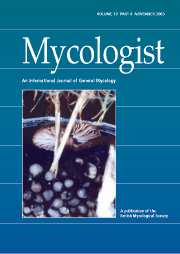Crossref Citations
This article has been cited by the following publications. This list is generated based on data provided by
Crossref.
Rodas, C. A.
Gryzenhout, M.
Myburg, H.
Wingfield, B. D.
and
Wingfield, M. J.
2005.
Discovery of the Eucalyptus canker pathogen Chrysoporthe cubensis on native Miconia (Melastomataceae) in Colombia.
Plant Pathology,
Vol. 54,
Issue. 4,
p.
460.
Cortinas, Maria-Noel
Crous, Pedro W.
Wingfield, Brenda D.
and
Wingfield, Michael J.
2006.
Multi-gene phylogenies and phenotypic characters distinguish two species within the Colletogloeopsis zuluensis complex associated with Eucalyptus stem cankers.
Studies in Mycology,
Vol. 55,
Issue. ,
p.
133.
Barreto, R. W.
Rocha, F. B.
and
Ferreira, F. A.
2006.
First record of natural infection of Marlierea edulis by the eucalyptus canker fungus Chrysoporthe cubensis.
Plant Pathology,
Vol. 55,
Issue. 4,
p.
577.
GRYZENHOUT, Marieka
RODAS, Carlos A.
MENA PORTALES, Julio
CLEGG, Paul
WINGFIELD, Brenda D.
and
WINGFIELD, Michael J.
2006.
Novel hosts of the Eucalyptus canker pathogen Chrysoporthe cubensis and a new Chrysoporthe species from Colombia.
Mycological Research,
Vol. 110,
Issue. 7,
p.
833.
Guimarães, Lúcio Mauro da Silva
Resende, Marcos Deon Vilela de
Lau, Douglas
Rosse, Leonardo Novaes
Alves, Alexandre Alonso
and
Alfenas, Acelino Couto
2010.
Genetic control of Eucalyptus urophylla and E. grandis resistance to canker caused by Chrysoporthe cubensis.
Genetics and Molecular Biology,
Vol. 33,
Issue. 3,
p.
525.
Pérez, C. A.
Wingfield, M. J.
Slippers, B.
Altier, N. A.
and
Blanchette, R. A.
2010.
Endophytic and canker-associated Botryosphaeriaceae occurring on non-native Eucalyptus and native Myrtaceae trees in Uruguay.
Fungal Diversity,
Vol. 41,
Issue. 1,
p.
53.
Chen, S. F.
Gryzenhout, M.
Roux, J.
Xie, Y. J.
Wingfield, M. J.
and
Zhou, X. D.
2010.
Identification and Pathogenicity of Chrysoporthe cubensis on Eucalyptus and Syzygium spp. in South China.
Plant Disease,
Vol. 94,
Issue. 9,
p.
1143.
van der Merwe, N. A.
Steenkamp, E. T.
Rodas, C.
Wingfield, B. D.
and
Wingfield, M. J.
2013.
Host switching between native and non‐native trees in a population of the canker pathogen Chrysoporthe cubensis from Colombia.
Plant Pathology,
Vol. 62,
Issue. 3,
p.
642.
Mausse-Sitoe, Silvia N.D.
Rodas, Carlos A.
Wingfield, Michael J.
Chen, ShuaiFei
and
Roux, Jolanda
2016.
Endophytic Cryphonectriaceae on native Myrtales: Possible origin of Chrysoporthe canker on plantation-grown Eucalyptus.
Fungal Biology,
Vol. 120,
Issue. 6-7,
p.
827.
Soares, Thaissa P. F.
Ferreira, Maria A.
Mafia, Reginaldo G.
Oliveira, Leonardo S. S.
Hodges, Charles S.
and
Alfenas, Acelino C.
2018.
Canker disease caused by Chrysoporthe doradensis and C. cubensis on Eucalyptus sp. and Tibouchina spp. in Brazil.
Tropical Plant Pathology,
Vol. 43,
Issue. 4,
p.
314.
Ali, Daniel B.
Marincowitz, Seonju
Wingfield, Michael J.
Roux, Jolanda
Crous, Pedro W.
and
McTaggart, Alistair R.
2018.
Novel Cryphonectriaceae from La Réunion and South Africa, and their pathogenicity on Eucalyptus.
Mycological Progress,
Vol. 17,
Issue. 8,
p.
953.
Chungu, Donald
Siyingwa, Jedrick
Ng’andwe, Phillimon
and
Chitala Chungu, Bertha
2019.
Lesion size induced by Chrysoporthe fungal pathogens varies between Eucalyptus species and geographic locations in Zambia.
Southern Forests: a Journal of Forest Science,
Vol. 81,
Issue. 1,
p.
39.
Ferreira, Maria Alves
de Oliveira, Mara Elisa Soares
Silva, Gabrielle Avelar
Mathioni, Sandra Marisa
and
Mafia, Reginaldo Gonçalves
2019.
Capillaureum caryovora gen. sp. nov. (Cryphonectriaceae) pathogenic to pequi (Caryocar brasiliense) in Brazil.
Mycological Progress,
Vol. 18,
Issue. 3,
p.
385.
Silva, Ximena
Roux, Jolanda
and
Asiegbu, Fred O.
2020.
Diseases of Eucalypts in Paraguay and First Report of Teratosphaeria zuluensis from South America.
Forests,
Vol. 11,
Issue. 10,
p.
1035.
2021.
Dahali, Rasdianah
Md Tahir, Paridah
Lee, Seng Hua
and
Jun, Zhang
2024.
Eucalyptus.
p.
17.
Tarigan, Marthin
Wingfield, Michael J
Jami, Fahimeh
Marpaung, Yosep MAN
Durán, Alvaro
and
Pham, Nam Q
2024.
Pathogenicity of
Chrysoporthe deuterocubensis
on eucalypts in Indonesia
.
Southern Forests: a Journal of Forest Science,
Vol. 86,
Issue. 1,
p.
42.
Silva, Gabrielle Avelar
Oliveira, Mara Elisa Soares
Rêgo, Géssica Mylena Santana
Wingfield, Brenda D.
Wingfield, Michael J.
and
Ferreira, Maria Alves
2024.
Chrysoporthe brasiliensis sp. nov. pathogenic to Melastomataceae in southeast Brazil.
Fungal Biology,
Vol. 128,
Issue. 3,
p.
1790.
Pham, Nam Q.
Wingfield, Brenda D.
Marincowitz, Seonju
Brawner, Jeremy T.
Hulcr, Jiri
and
Wingfield, Michael J.
2025.
Cryphonectria Canker on Eucalyptus in Florida Reconsidered.
Forest Pathology,
Vol. 55,
Issue. 4,
Wingfield, Michael J.
Pham, Nam Q.
Marincowitz, Seonju
and
Wingfield, Brenda D.
2025.
Cryphonectriaceae: Biodiverse and Threatening Tree Pathogens in the Tropics and Southern Hemisphere.
Annual Review of Phytopathology
,
Vol. 63,
Issue. 1,
p.
553.

